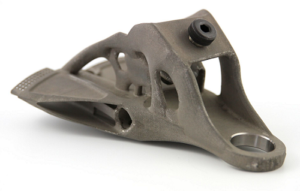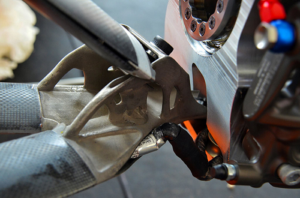InMotion Electric Race Car Hits the Track for a Record-Breaking Run with Materialise and 3D Printed Titanium Y-Joints
InMotion is made up of engineering students from the Technical University of Eindhoven (TU/e), and the team has set some pretty major goals for its electric race car – compete in the legendary, difficult 24 Hours of Le Mans race by 2019, after first breaking the electric-track record (set by Stefan Bellof in 1983) at the Nürburgring in Germany next year. InMotion is currently working with Materialise to design and 3D print titanium parts for its IM/e race car.
Talk about ambitious! The systems being tested on the IM/e, which is really a test platform, will eventually be transferred over to the completed IM01 race car, which will compete in the 24 Hours of Le Mans race. Weight optimization is a big deal when you’re attempting to make the fastest electric car in the world, and InMotion decided to use lightweight titanium to produce 3D printed wishbones, or Y-joints, for the car’s suspension.For the uninitiated, wishbones connect the uprights to the car’s chassis, and hold the wheels in place while also handling all the forces that the car is subjected to, so it’s a pretty important part. While titanium itself has a low specific weight, Materialise’s engineering team used its Materialise 3-matic software program to make the part that InMotion designed even lighter by filling its hollow cavities with a honeycomb structure; this allowed the part to be lighter weight without losing any load-bearing strength.According to InMotion’s website, “We aim to drive faster than a Formula 1 car, but for 24 consecutive hours and with just half the fuel.”
InMotion also wanted to avoid the use of support structures that would have to be removed manually after the printing process, as the team didn’t want the removal to add any last-minute difficulties to the fit of certain parts, like the IM/e’s suspension arms. The arms are connected to the uprights with spherical ball bearings, and it’s vital that the components have the proper fit.
“Thanks to our software, we can find a build orientation that allows us to print the part as a self-supporting structure, removing the need for a generated support structure,” Jannis Kranz, Design Engineer for Metal 3D Printing at Materialise, said in a case study. “It was a great challenge for our Metal Printing Factory in Bremen, but all in all, the lead time for the entire project was under one working week.”
As if the one-week turnaround at the Bremen factory wasn’t enough, Materialise’s software was able to deliver the part with the team’s desired precision as well.
- [Images: InMotion]
InMotion Advisory Board Member Rogier de Rijk said, “The precise fit that was needed for the assembly of the suspension arms didn’t cause us any trouble. The accuracy was high: everything fit perfectly from the outset. Any small imperfection would have come up during assembly.”
After all of the years that InMotion has spent on research and development, and thanks to its collaboration with Materialise, the team’s electric race car is really starting to get some good results and attract attention, especially after its record-breaking circuit run earlier this month at Zandvoort, the largest and most prestigious racetrack in the Netherlands.
InMotion wanted to to break the record at Zandvoort to prepare for the 24 Hours of Le Mans competition. The IM/e, and team driver Beitske Visser, outperformed its own goal and smashed the previous electric lap time by a whopping 16 seconds, completing the circuit in just 1:48.371 and setting a new lap record.
“We’re incredibly excited by this result. It’s just one step closer to achieving our ultimate goal: completing the 24 hour race at Le Mans,” said Arthur van der Werf, InMotion’s Chief of Marketing and Communication. “The IM/e is an ideal testing ground for new technologies, and racing at Zandvoort is a great way to see what’s working and what needs to be changed.”
The Le Mans racetrack is tough, and the 24-hour race is challenging even for conventional race cars. But InMotion will continue testing its IM/e and IM01 race cars, with 3D printed wishbones, on more racetracks to keep fine-tuning the cars’ performances.
Materialise’s Stephanie Benoit wrote about InMotion in a blog post, “After the result at Zandvoort, we’re feeling confident about their chances!”
Check out the record-breaking run below:
Recordronde Zandvoort InMotion IM/e
Na hard werken hebben wij het voor elkaar gekregen om met onze zelfgebouwde raceauto het record te breken. Race mee met Beitske Visser in onze IM/e tijdens de recordronde op Circuit Zandvoort! Lijkt het jou gaaf om volgend jaar met een team naar eenzelfde hoogtepunt te werken? Maak het onmogelijke waar en solliciteer bij hr@inmotion.tue.nl voor 12 juni.
Posted by InMotion on Wednesday, 7 June 2017
Discuss in the Materialise forum at 3DPB.com.
Subscribe to Our Email Newsletter
Stay up-to-date on all the latest news from the 3D printing industry and receive information and offers from third party vendors.
You May Also Like
Profiling a Construction 3D Printing Pioneer: US Army Corps of Engineers’ Megan Kreiger
The world of construction 3D printing is still so new that the true experts can probably be counted on two hands. Among them is Megan Kreiger, Portfolio Manager of Additive...
US Army Corps of Engineers Taps Lincoln Electric & Eaton for Largest 3D Printed US Civil Works Part
The Soo Locks sit on the US-Canadian border, enabling maritime travel between Lake Superior and Lake Huron, from which ships can reach the rest of the Great Lakes. Crafts carrying...
Construction 3D Printing CEO Reflects on Being Female in Construction
Natalie Wadley, CEO of ChangeMaker3D, could hear the words of her daughter sitting next to her resounding in her head. “Mum, MUM, you’ve won!” Wadley had just won the prestigious...
1Print to Commercialize 3D Printed Coastal Resilience Solutions
1Print, a company that specializes in deploying additive construction (AC) for infrastructure projects, has entered an agreement with the University of Miami (UM) to accelerate commercialization of the SEAHIVE shoreline...




































